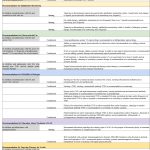The ACR recently released two new clinical practice guidelines pertaining to the management of juvenile idiopathic arthritis (JIA).1,2 Among their key recommendations are decreased reliance on long-term corticosteroids and non-steroidal anti-inflammatory drugs (NSAIDs), early use of biologic and conventional disease-modifying anti-rheumatic drugs (DMARDs) and an emphasis on shared decision making with patients and caregivers.
Part 2 of the JIA Update
The ACR released initial guidelines for JIA in 2011 and 2013, and began an update process in 2017 in response to the rapidly changing nature of the field, which included the approval of new treatments and increased clinical experience using others.3,4 Due to the breadth of topics that needed to be covered, including broad clinical manifestations seen in the seven different subtypes of JIA, the work was eventually split into four papers.
The two papers published in 2019 covered non-systemic polyarthritis, sacroiliitis, enthesitis and uveitis. The other two guidelines were recently published. One addresses oligoarthritis, temporomandibular joint (TMJ) arthritis and systemic JIA, with and without macrophage activation syndrome (see Figures 1–3).5 The other provides general recommendations with respect to all JIA types for nonpharmacological treatments, medication monitoring, immunizations and imaging.6
Relevant clinical questions were first developed using the PICO (i.e., population, intervention, comparator and outcomes) format. After a comprehensive literature review, a panel of adult patients and patient family members provided their perspectives to a voting panel, which included two of the patient panel members. Voting panel members then provided specific conditional or strong recommendations using GRADE (i.e., Grading of Recommendations, Assessment, Development and Evaluation) methodology, which has been used for other recent ACR guidelines.

Dr. Onel
Karen B. Onel, MD, chief of the Pediatric Rheumatology Division at the Hospital for Special Surgery, New York City and the lead investigator for the two most recent JIA guidelines, notes that the evidence base for pediatric rheumatology is extremely limited, with none of the recommendations supported by moderate to high-quality evidence. However, existing literature and literature from closely related diseases heavily inform these recommendations.
Key Themes
Escalate treatment when appropriate
Another voting panel member, Randy Q. Cron, MD, PhD, director of the Division of Pediatric Rheumatology, the University of Alabama at Birmingham, notes that part of the guideline focus was to recommend escalating to biologics more rapidly than many clinicians have done in the past to provide faster and better disease control with fewer side effects.


